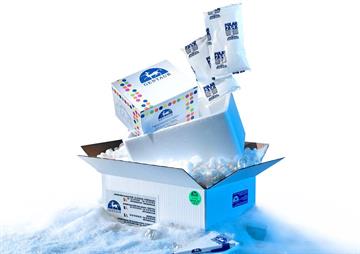Recombinant Human CD86 Protein

Recombinant Human CD86 Protein
10302.12 EUR
In Stock
quantity
Produktdetaljer
Katalognummer: 544 - MBS8248741-5x05mg
Produktkategori: Företag och industri > Vetenskap och laboratorium
MyBiosourceGentaur
Storlek: 5x0.5mg
Related Products
KIF1A-1121H
RecombinantHuman KIF1A Protein, His-tagged
Store at 2-8 centigrade for one month. Aliquot and store at -80 centigrade for 12 months.
617.6 €
96-127
CD86 Recombinant Protein
Cluster of Differentiation 86 (CD86) is also known as B-lymphocyte activation antigen B7-2, is a type I membrane protein that is a member of the immunoglobulin superfamily, and is constitutively expressed on interdigitating dendritic cells, Langerhans cells, peripheral blood dendritic cells, memory B cells, and germinal center B cells. Additionally, B72 is expressed at low levels on monocytes and can be upregulated through interferon γ. CD86 is the ligand for two different proteins on the T cell surface: CD28 (for autoregulation and intercellular association) and CTLA-4 (for attenuation of regulation and cellular disassociation). CD86 works in tandem with CD80 to prime T cells. Recent study has revealed that B7-2 promotes the generation of a mature APC repertoire and promotes APC function and survival. Furthermore, the B7 proteins are also involved in innate immune responses by activating NF-κB-signaling pathway in macrophages. CD86 thus is regarded as a promising candidate for immune therapy. CD86+ macrophages in Hodgkin lymphoma patients are an independent marker for potential nonresponse to firstline-therapy.
1201.45 €
90-405
CD86 Recombinant Protein
CD86 (B7-2) is a 60-100 kDa variably glycosylated protein in the B7 family. B7 family members are transmembrane cell surface molecules that play important roles in immune activation and the maintenance of immune tolerance. B7-2 is highly expressed on activated antigen presenting cells (APC), e.g. B cells, dendritic cells and monocytes as well as on vascular endothelial cells. B7-2 and the closely related CD80 (B7-1) exhibit overlapping but distinct functional properties. Their binding to CD28, which is constitutively expressed on T cells, enhances T cell receptor signaling and also provides TCR-independent costimulation. B7-1 and B7-2 additionally bind the CD28-related protein CTLA-4, which is up-regulated and recruited to the immunological synapse (IS) at the onset of T cell activation. CTLA-4 ligation inhibits the T cell response and supports regulatory T cell function. B7-2 is expressed earlier than B7-1 following APC activation and both proteins bind with higher affinity to CTLA-4 than to CD28. B7-2 promotes the stabilization of CD28 in the IS, while B7-1 is primarily responsible for promoting CTLA-4 recruitment and accumulation in the IS. The relative participation of B7-1 and B7-2 in T cell costimulation can also alter the Th1/Th2 bias of the immune response. Both B7-1 and B7-2 serve as cellular receptors for B species adenoviruses.
1106.95 €
90-406
CD86 Recombinant Protein
CD86 (B7-2) is a 60-100 kDa variably glycosylated protein in the B7 family. B7 family members are transmembrane cell surface molecules that play important roles in immune activation and the maintenance of immune tolerance. B7-2 is highly expressed on activated antigen presenting cells (APC), e.g. B cells, dendritic cells and monocytes as well as on vascular endothelial cells. B7-2 and the closely related CD80 (B7-1) exhibit overlapping but distinct functional properties. Their binding to CD28, which is constitutively expressed on T cells, enhances T cell receptor signaling and also provides TCR-independent costimulation. B7-1 and B7-2 additionally bind the CD28-related protein CTLA-4, which is up-regulated and recruited to the immunological synapse (IS) at the onset of T cell activation. CTLA-4 ligation inhibits the T cell response and supports regulatory T cell function. B7-2 is expressed earlier than B7-1 following APC activation and both proteins bind with higher affinity to CTLA-4 than to CD28. B7-2 promotes the stabilization of CD28 in the IS, while B7-1 is primarily responsible for promoting CTLA-4 recruitment and accumulation in the IS. The relative participation of B7-1 and B7-2 in T cell costimulation can also alter the Th1/Th2 bias of the immune response. Both B7-1 and B7-2 serve as cellular receptors for B species adenoviruses.
1106.95 €
Håll dig uppdaterad! Visa tidigare publikationer

By: Author , 2 Comment
Anaplasmos hos hundar och katter – allt du behöver veta
23 August 2025

By: Author , 2 Comment
Solbränna – hur leker man säkert i solen?
16 August 2025

By: Author , 2 Comment
Biologiska läkemedel – Modernitet inom farmaci
1 August 2025

By: Author , 2 Comment
Icke-steroida antiinflammatoriska läkemedel – viktig information om populära läkemedel
22 July 2025








